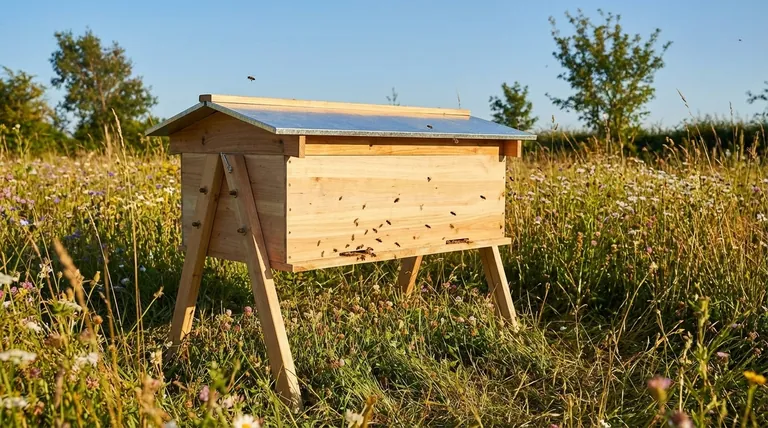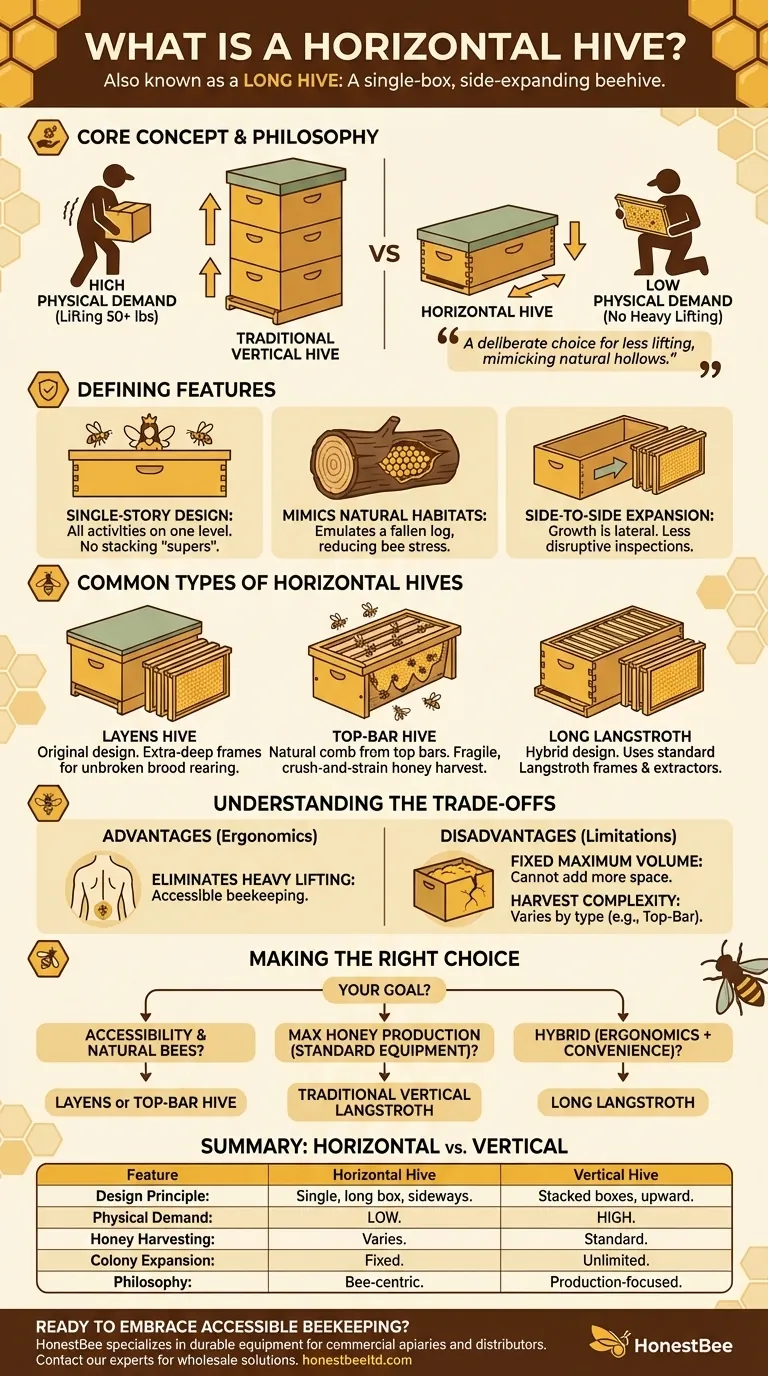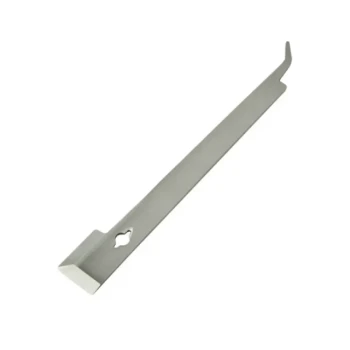At its core, a horizontal hive is most commonly known as a long hive. This general term describes any single-box beehive that expands sideways rather than vertically. Specific designs exist under this umbrella, with the most historically significant being the Layens hive, named after its 19th-century inventor.
The name is less important than the philosophy it represents. Opting for a horizontal hive is a deliberate choice for a beekeeping style that prioritizes less heavy lifting and mimics the natural, hollow spaces that bees prefer in the wild.

What Defines a Horizontal Hive?
Unlike the more common stacked-box hives (like the Langstroth), horizontal hives operate on a fundamentally different principle of management and expansion.
A Single-Story Design
The most defining feature is its construction as a single, long box. All beekeeping activities—from brood rearing to honey storage—happen on one level.
This eliminates the need to lift and stack heavy boxes ("supers") weighing 50 pounds or more, which is the most physically demanding part of traditional beekeeping.
Mimicking Natural Bee Habitats
Horizontal hives are designed to emulate the shape of a fallen log or tree hollow. Bees in nature build their nests out horizontally in these types of cavities.
This "bee-centric" design philosophy suggests that this shape is more aligned with a colony's natural instincts, potentially reducing stress on the bees.
Side-to-Side Expansion
As the colony grows, the beekeeper adds empty frames to the side, not on top. The queen and brood nest tend to stay in the center, with honey and pollen stored on the outer frames.
Inspections can be less disruptive, as you can often check just a few frames on the edge without disturbing the central brood nest.
Common Types of Horizontal Hives
While "long hive" is the generic term, several specific designs are popular, each with its own characteristics.
The Layens Hive
The Layens is the original, archetypal horizontal hive. Invented by Georges de Layens in France, its defining feature is its extra-deep frames.
These large frames provide an unbroken area for the queen to lay eggs, closely mimicking the structure of a wild comb and allowing for a large, robust winter cluster.
The Top-Bar Hive
A top-bar hive is a simple, trough-like long hive where bees build their comb directly down from wooden bars placed across the top. It does not use the four-sided frames found in other hives.
This design is popular in natural beekeeping circles because it allows bees to build their comb to whatever cell size they choose. However, the combs are more fragile and cannot be spun in a standard honey extractor.
The Long Langstroth
This is a hybrid design. It is a horizontal hive box built to hold standard Langstroth frames.
This offers the primary ergonomic benefit of a long hive (no heavy lifting) while allowing the beekeeper to use standard equipment, including frames and foundation. It also makes honey extraction easier as the frames fit into conventional centrifugal extractors.
Understanding the Trade-offs
Choosing a horizontal hive is a choice with clear benefits and distinct limitations. It is not inherently better or worse, but simply different.
Advantage: Ergonomics
The single greatest advantage is the elimination of heavy lifting. This makes beekeeping far more accessible to people with back problems, physical limitations, or who simply prefer less strenuous work.
Disadvantage: Expansion Limits
A horizontal hive has a fixed maximum volume. You cannot add more space once the hive is full. In a massive nectar flow, a highly productive colony could run out of room, potentially limiting the honey harvest or encouraging the colony to swarm.
Disadvantage: Honey Harvesting Methods
With Layens or Top-Bar hives, honey extraction can be more complex. Top-bar combs are too fragile for centrifugal extractors and must be cut and crushed. While effective, this process is slower and results in the loss of the drawn beeswax comb, which the bees must rebuild. The Long Langstroth avoids this specific issue.
Making the Right Choice for Your Goal
The best hive is the one that aligns with your physical abilities, beekeeping philosophy, and ultimate objectives.
- If your primary focus is accessibility and natural beekeeping: The minimal lifting and bee-centric design of a Layens or Top-Bar hive is an excellent choice.
- If your primary focus is maximizing honey production with industry-standard equipment: A traditional vertical Langstroth hive remains the most common and efficient choice.
- If your primary focus is a hybrid of ergonomics and convenience: The Long Langstroth provides the no-lifting benefits of a horizontal hive while using standard, interchangeable frames.
Ultimately, understanding these designs empowers you to select a hive that aligns perfectly with your personal beekeeping philosophy.
Summary Table:
| Feature | Horizontal Hive (Long Hive) | Traditional Vertical Hive (e.g., Langstroth) |
|---|---|---|
| Design Principle | Single, long box; expands sideways | Stacked boxes; expands upward |
| Physical Demand | Low - No heavy lifting of supers | High - Requires lifting 50+ lb boxes |
| Honey Harvesting | Varies by type (crush & strain for Top-Bar) | Standard (frames fit centrifugal extractors) |
| Colony Expansion | Fixed maximum volume | Virtually unlimited by adding more boxes |
| Philosophy | Bee-centric, mimics natural habitats | Production-focused, industry standard |
Ready to embrace a more accessible, bee-centric approach to beekeeping?
At HONESTBEE, we specialize in supplying the durable equipment and supplies that commercial apiaries and distributors need to succeed. Whether you're considering a horizontal hive design for its ergonomic benefits or need reliable components for any beekeeping operation, our wholesale-focused team is here to support your business.
Contact our experts today to discuss how our products can help you build a more sustainable and efficient apiary.
Visual Guide

Related Products
- Long Langstroth Style Horizontal Top Bar Hive for Wholesale
- HONESTBEE Professional Long Handled Hive Tool with Precision Cutting Blade
- HONESTBEE Advanced Ergonomic Stainless Steel Hive Tool for Beekeeping
- HONESTBEE Professional Multi-Functional Hive Tool with Ergonomic Wood Handle
- Top Bar Beehive for Beekeeping Wholesales Kenya Top Bar Hive
People Also Ask
- How does the top bar hive help control varroa mites? A Natural Approach to Mite Management
- How does the design of a top bar hive benefit beekeepers? Ergonomic & Natural Beekeeping for Hobbyists
- What are the benefits of the top bar hive? A Guide to Ergonomic, Natural Beekeeping
- What are the advantages of a top bar hive? Simpler, Bee-Centric Beekeeping for All
- What are the box management requirements for a top bar hive vs. Langstroth? Choose Your Hive Strategy



















